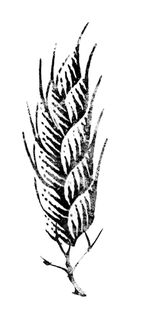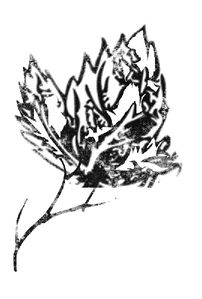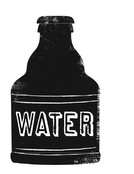The Naked Pint (2 page)
Authors: Christina Perozzi

Yes, We’re Women and We Drink Beer


 Water
Water
 Yeast
Yeast
A
s women, we’ve found that people have been surprised at our love of beer. The truth is, women have been brewing and drinking beer for thousands of years. Women are out there drinking craft beer and brewing and writing about it every day, so there’s no reason women should feel that beer is not for the ladies. It’s true that the image of women and beer on the tube has generally involved double-D boobs and a wet T-shirt, but we can assure you, our T-shirts are dry. And, though we think craft beer is indeed sexy and are sometimes happy to wear six inch heels while drinking an Abbey Dubbel, beer is
not
only an afterthought of female stereotypes. We understand that people have been misleading women for years about the caloric content of beer and the necessity of drinking a light beer in order to seem ladylike. But no one really subscribes to this anymore. Women who come to our events are fascinated by the flavors of craft beer. Young or old, once they’ve had their first sour cherry Lambic or chocolaty Porter, they are on board in a big, big way. And we are thrilled to be a part of this growing community. Let’s be honest, what’s sexier than a woman who knows her craft beer?
A Final Words women, we’ve found that people have been surprised at our love of beer. The truth is, women have been brewing and drinking beer for thousands of years. Women are out there drinking craft beer and brewing and writing about it every day, so there’s no reason women should feel that beer is not for the ladies. It’s true that the image of women and beer on the tube has generally involved double-D boobs and a wet T-shirt, but we can assure you, our T-shirts are dry. And, though we think craft beer is indeed sexy and are sometimes happy to wear six inch heels while drinking an Abbey Dubbel, beer is
not
only an afterthought of female stereotypes. We understand that people have been misleading women for years about the caloric content of beer and the necessity of drinking a light beer in order to seem ladylike. But no one really subscribes to this anymore. Women who come to our events are fascinated by the flavors of craft beer. Young or old, once they’ve had their first sour cherry Lambic or chocolaty Porter, they are on board in a big, big way. And we are thrilled to be a part of this growing community. Let’s be honest, what’s sexier than a woman who knows her craft beer?
T
his book is not meant to be the final word on any aspect of beer. We bring you our thoughts as participants in the craft beer community. We love being a part of the dialogue that is present in the craft world today. As the community grows, so do the differences of opinion and the discussion on style and ratings and a multitude of other topics. For us, it’s always about being inclusive and sharing the knowledge with anyone who wants it. As you enter the craft beer world, you enter a world that is accessible. The learning curve for beer is quick, and after Beer 101, you will already know more about beer than most people in the bar. We love that the beer world is not a lofty, exclusive one. No one need pass a coolness test to drink this fine beverage. Though beer snobs do exist (and yes, we’ve been known to raise our nose a few times), we try to bring it back to the fact that craft beer is meant to be enjoyed, not worshiped; not used to alienate, but to bring communities together to toast the events of the day and the changing of the seasons. When the beer talk gets too haughty, we simply excuse ourselves and go open a bottle of Saison. Though we may drink the beer from proper glassware and pair Witbiers with fresh seafood, we never lose sight of our simple credo:
Beer is good.
his book is not meant to be the final word on any aspect of beer. We bring you our thoughts as participants in the craft beer community. We love being a part of the dialogue that is present in the craft world today. As the community grows, so do the differences of opinion and the discussion on style and ratings and a multitude of other topics. For us, it’s always about being inclusive and sharing the knowledge with anyone who wants it. As you enter the craft beer world, you enter a world that is accessible. The learning curve for beer is quick, and after Beer 101, you will already know more about beer than most people in the bar. We love that the beer world is not a lofty, exclusive one. No one need pass a coolness test to drink this fine beverage. Though beer snobs do exist (and yes, we’ve been known to raise our nose a few times), we try to bring it back to the fact that craft beer is meant to be enjoyed, not worshiped; not used to alienate, but to bring communities together to toast the events of the day and the changing of the seasons. When the beer talk gets too haughty, we simply excuse ourselves and go open a bottle of Saison. Though we may drink the beer from proper glassware and pair Witbiers with fresh seafood, we never lose sight of our simple credo:
Beer is good.
ONE
Beer 101
He was a wise man who invented beer.
—PL ATO
What You Never Learned in SchoolY
ou’ve learned many useful things in life. You learned how to walk, how to tie your shoe, how to ride a bicycle without training wheels. In school, they taught you the three R’s and how to dissect Dostoyevsky. In home ec, you learned how to make an apple turnover and balance a checkbook. But when it came to beer, the only resource you had was your older brother, whose idea of a perfect evening was shot-gunning a beer and chasing it with a whippet in the local Kmart parking lot. His only concern, when it came to beer, was quantity versus cooler size. Let’s be honest, if you dropped him in any craft beer bar today, he’d be considered “that guy”—the one who thinks his mass-produced light lager of choice is the be-all and end-all of beers and the only one he’ll drink forever, no matter what occurs. Hey, we’re women, we’re down with commitment, but even we refuse to be chained to one beer for the rest of our lives.
ou’ve learned many useful things in life. You learned how to walk, how to tie your shoe, how to ride a bicycle without training wheels. In school, they taught you the three R’s and how to dissect Dostoyevsky. In home ec, you learned how to make an apple turnover and balance a checkbook. But when it came to beer, the only resource you had was your older brother, whose idea of a perfect evening was shot-gunning a beer and chasing it with a whippet in the local Kmart parking lot. His only concern, when it came to beer, was quantity versus cooler size. Let’s be honest, if you dropped him in any craft beer bar today, he’d be considered “that guy”—the one who thinks his mass-produced light lager of choice is the be-all and end-all of beers and the only one he’ll drink forever, no matter what occurs. Hey, we’re women, we’re down with commitment, but even we refuse to be chained to one beer for the rest of our lives.
So let’s begin. With Beer 101 you will impress your friends, your date, your bartenders, and your parents (well, maybe not your parents). This will set you on the right path to drinking and loving great beer.
The goal of Beer 101 is to debunk many misconceptions that people have about beer, and to raise it to the level that it deserves as an artisanal and craft beverage. When you graduate from Beer 101, you will have a rudimentary understanding of what beer is. You will know what goes into it, how to describe it, how to taste it, how to order it, and, yes, how to drink it without feeling like a total idiot. In fact, we’ll let you in on a little secret: Unlike calculus, the learning curve for beer is quick! After you discover the basics, your knowledge will be far beyond what most people know about this misunderstood beverage. It’s part of the beauty of beer.
What the Hell Is Beer Anyway?W
ine is easy to understand. You pick some grapes, you crush them, and then you let them sit around for a while until you get wine. Hell, even the
I Love Lucy
girls understood that. Of course, we realize that winemaking is a much more detailed and complicated process. We know that winemaking concerns the growing of the grapes and the quality of the
terroir
, the wood used in fermenting, varietals of the grapes, AOCs, stems on versus stems off, and so on. But even the most devout winemakers will tell you that when you really get right down to it, wine in its simplest form is fermented grape juice. We get it. You get it. But do
ine is easy to understand. You pick some grapes, you crush them, and then you let them sit around for a while until you get wine. Hell, even the
I Love Lucy
girls understood that. Of course, we realize that winemaking is a much more detailed and complicated process. We know that winemaking concerns the growing of the grapes and the quality of the
terroir
, the wood used in fermenting, varietals of the grapes, AOCs, stems on versus stems off, and so on. But even the most devout winemakers will tell you that when you really get right down to it, wine in its simplest form is fermented grape juice. We get it. You get it. But do
WHAT IS THE BIG DEAL ABOUT MICROBREWS AND CRAFT BEER?

In the late 1970s and early 1980s, Jimmy Carter gave a great gift to beer lovers everywhere by signing the bill that decriminalized the home brewing of beer. Beer connoisseurs were tired of industrialized, watered-down, mass-produced beers made from inferior and inexpensive ingredients like corn and rice. They were inspired by the master brewers in Europe and finally had the law on their side to begin the art of homebrew. Brewers began their own small breweries using quality ingredients like barley, rye, wheat, herbs, fruits, and spices. It was called the Craft Beer Revolution.
The term microbrew is used today to describe a high-quality beer that comes from a brewery that produces fewer than 15,000 barrels per year. The term craft beer refers to beer from breweries that may have grown too large to be considered micro but that are still producing artisanal, specialty beers.
you have any idea what beer is? Only a chosen few are in the know. Join us, won’t you?
Beer in its most basic form is a
carbonated alcoholic beverage
made from
fermented grains
. It is primarily made up of four key ingredients: malt, hops, water, and yeast. Feel smarter already? You should. You now know more than most people do about beer. (We told you the learning curve was quick.) Now let’s take a closer look. What exactly are these ingredients?
Maltcarbonated alcoholic beverage
made from
fermented grains
. It is primarily made up of four key ingredients: malt, hops, water, and yeast. Feel smarter already? You should. You now know more than most people do about beer. (We told you the learning curve was quick.) Now let’s take a closer look. What exactly are these ingredients?
What do Whoppers, Long John Silver’s, Ovaltine, and beer all have in common? Well, those chocolate-covered candies, the vinegar you sprinkle on your fish and chips, and that powder you stir into your milk are made with malt, which just happens to be the basis for all the color, alcohol content, viscosity, carbonation, and subsequent mouthfeel of beer. Malts are cereal grains that have gone through what those in the know call the malting process or, more simply, malting. Sound complicated? Well, it actually kind of is.

Have you ever tried to grow an herb garden that started from seeds? The first thing you’re supposed to do is put the seeds between a wet warm paper towel to let them sprout or germinate. Malting starts out with this same germination process. The cereal grains are soaked in water and allowed to just begin to sprout. For your garden, once the seeds sprouted, you’d plant them and watch them grow until you were ready to harvest your herbs. During the malting process, however, the growing process is immediately halted as soon as the cereal grain sprouts by a quick drying. This process allows the starch that exists in the seed to be usable as a fermentable sugar. During the brewing process, yeast consumes that sugar, and the byproducts of that process are carbon dioxide (CO
2
), or carbonation (beer bubbles), and alcohol (loud mouth soup).
2
), or carbonation (beer bubbles), and alcohol (loud mouth soup).
Once the grain is dried, it is roasted or baked or smoked or kilned to every degree of lightness or darkness under the sun, from the palest of pale to the deepest black malt. The color to which the malt has been roasted (and the combination of the colors of malt) is
solely
responsible for the color of that beer. (We’re going to be emphasizing this point a lot.) The amount of malt used, in conjunction with the amount of yeast used, is
solely
responsible for the alcohol content and carbonation of that beer.
Hopssolely
responsible for the color of that beer. (We’re going to be emphasizing this point a lot.) The amount of malt used, in conjunction with the amount of yeast used, is
solely
responsible for the alcohol content and carbonation of that beer.
We like to use the analogy that malts are the male part of beer. You have to encourage them to grow; you have to cajole, manipulate, and control them to make them useful. Hops are the female part of beer. They come in many varieties and can easily dominate, can be quite flowery, can be high maintenance, and are often bitter. (Just kidding... kind of.)
Hops are actually the female flowering cones of the vining hop plant: scientific name
Humulus lupulus
. Hops look like delicate, tiny green pinecones and are in the family of Cannabaceae, which also includes the genus
Cannabis
. That’s right, people, another reason to love beer is that hops are a cousin of cannabis, aka Mary Jane, weed, marijuana, grass, la molta, or, as our mothers call it, “the pot.”
Humulus lupulus
. Hops look like delicate, tiny green pinecones and are in the family of Cannabaceae, which also includes the genus
Cannabis
. That’s right, people, another reason to love beer is that hops are a cousin of cannabis, aka Mary Jane, weed, marijuana, grass, la molta, or, as our mothers call it, “the pot.”

If you don’t know what water is, then we’re not sure that we can help you. But what you might not know is that water type and quality are very important in the brewing of beer. The use of soft or hard water affects the flavor of beer in the same way that it affects any beverage, such as coffee or tea.

All right, let’s just get all the jokes out now. Just get ’em out! It’s a completely normal reaction. Believe us when we tell you that
Yeasty Girls
was on our short list of titles for this book just because it made us laugh. We know: Yeast is funny. Ready to move on?
Yeasty Girls
was on our short list of titles for this book just because it made us laugh. We know: Yeast is funny. Ready to move on?
Yeast is a living organism, which forms colonies of single, simple cells. Officially, scientists call this organism a fungus, but in the days of yore, before brewers fully understood the brewing process, yeast was simply called “God is good.” Yeasts are hungry little buggers who are responsible for “eating” fermentable sugars, producing CO
2
(beer bubbles) and alcohol (the hooch).
2
(beer bubbles) and alcohol (the hooch).
Other books
Welcome Back, Stacey! by Ann M Martin
Jake by R. C. Ryan
Trilby by Diana Palmer
Embracing the Wolf by Felicity Heaton
Break Me by Walker, Jo-Anna
Bitter Gold Hearts by Glen Cook
The Smoking Iron by Brett Halliday
Stranded by Jaymie Holland
Asking For Trouble by Kristina Lloyd
The Last Mile Home by Di Morrissey
